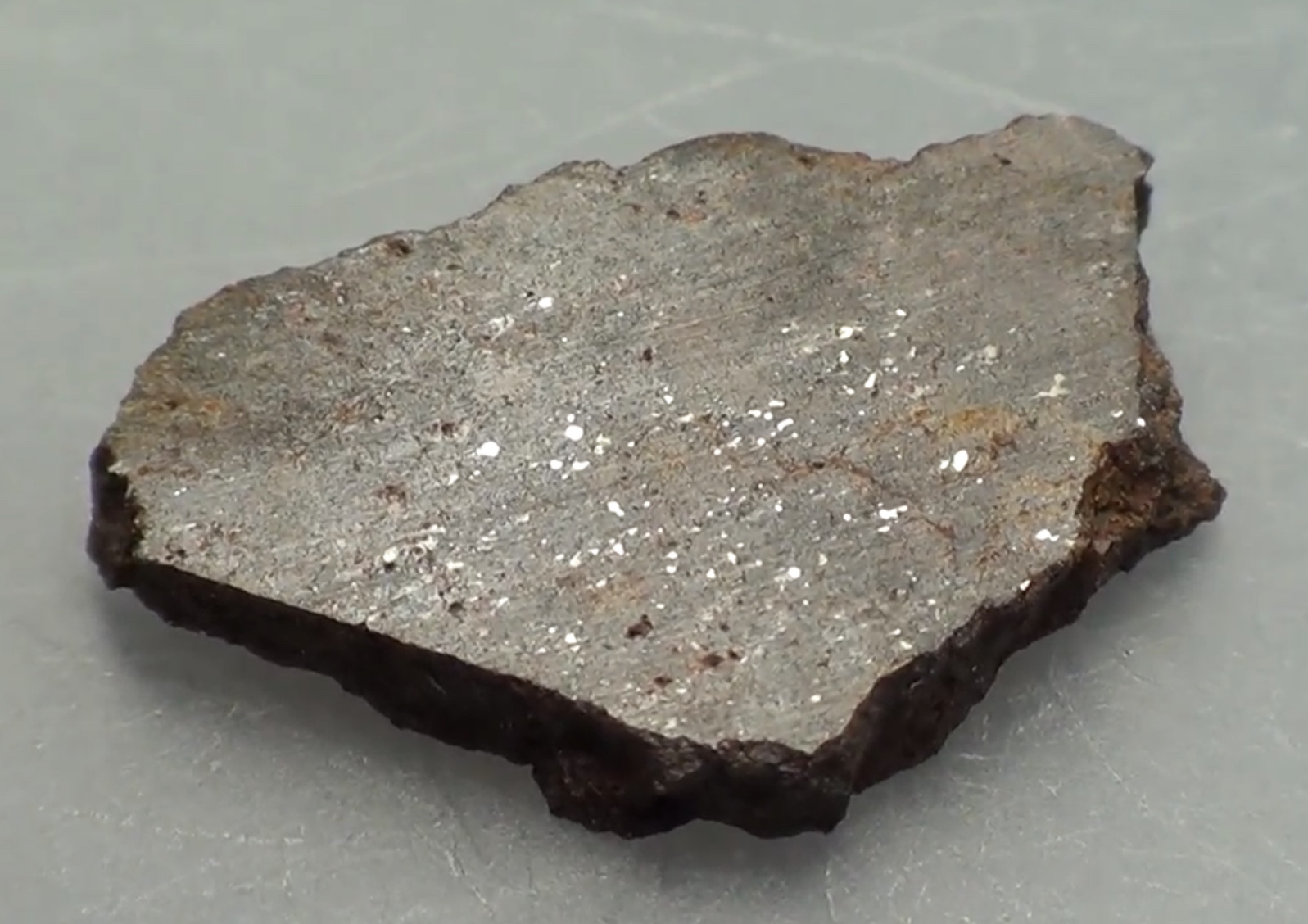|
Maskelynite
Maskelynite is a glassy material found in some meteorites and meteorite impact craters. Typical samples are similar in composition to plagioclase feldspar, and revert to that mineral when melted and recrystallized. It was named after British geologist M.H.N. Story-Maskelyne. Since maskelynite (like the volcanic glass obsidian) lacks an orderly arrangement of atoms, it is not considered a "mineral" by geologists, and is not listed as such by the Mineralogical Society of America. History The phase was first identified in the Shergotty meteorite by G. Tschermak (1872) as an isotropic glass of an unknown origin with near labradorite composition. Similar phases were found in chondrites and Martian meteorites. In 1963, D. J. Milton and P. S. de Carli produced a maskelynite-like glass by subjecting gabbro to an explosive shock wave. In 1967, T. E. Bunch and others identified maskelynite in the Clearwater West and Manicouagan impact structures. Origin At first, maskelynite was belie ... [...More Info...] [...Related Items...] OR: [Wikipedia] [Google] [Baidu] |
Glossary Of Meteoritics
This is a glossary of terms used in meteoritics, the science of meteorites. # * 2 Pallas – an asteroid from the asteroid belt and one of the likely parent bodies of the CR meteorites. * 4 Vesta – second-largest asteroid in the asteroid belt and likely source of the HED meteorites. * 221 Eos – an asteroid from the asteroid belt and one of the likely parent bodies of the CO meteorites. * 289 Nenetta – an asteroid from the asteroid belt and one of the likely parent bodies of the angrites. * 3103 Eger – an asteroid from the asteroid belt and one of the likely parent bodies of the aubrites. * 3819 Robinson – an asteroid from the asteroid belt and one of the likely parent bodies of the angrites. * IA meteorite – an iron meteorite group now part of the IAB group/complex. * IAB meteorite – an iron meteorite and primitive achondrite of the IAB group/complex. * IB meteorite – an iron meteorite group now part of the IAB group/complex. * IC meteorite – ... [...More Info...] [...Related Items...] OR: [Wikipedia] [Google] [Baidu] |
Glass
Glass is a non-Crystallinity, crystalline, often transparency and translucency, transparent, amorphous solid that has widespread practical, technological, and decorative use in, for example, window panes, tableware, and optics. Glass is most often formed by rapid cooling (quenching) of the Melting, molten form; some glasses such as volcanic glass are naturally occurring. The most familiar, and historically the oldest, types of manufactured glass are "silicate glasses" based on the chemical compound silicon dioxide, silica (silicon dioxide, or quartz), the primary constituent of sand. Soda–lime glass, containing around 70% silica, accounts for around 90% of manufactured glass. The term ''glass'', in popular usage, is often used to refer only to this type of material, although silica-free glasses often have desirable properties for applications in modern communications technology. Some objects, such as drinking glasses and glasses, eyeglasses, are so commonly made of silicate- ... [...More Info...] [...Related Items...] OR: [Wikipedia] [Google] [Baidu] |
Chondrites
A chondrite is a stony (non-metallic) meteorite that has not been modified, by either melting or differentiation of the parent body. They are formed when various types of dust and small grains in the early Solar System accreted to form primitive asteroids. Some such bodies that are captured in the planet's gravity well become the most common type of meteorite by (whether quickly, or after many orbits) arriving on a trajectory toward the planet's surface. Estimates for their contribution to the total meteorite population vary between 85.7% and 86.2%. Their study provides important clues for understanding the origin and age of the Solar System, the synthesis of organic compounds, the origin of life and the presence of water on Earth. One of their characteristics is the presence of chondrules (from the Ancient Greek χόνδρος ''chondros'', grain), which are round grains formed as molten, or partially molten droplets, in the space by distinct minerals, that normally constit ... [...More Info...] [...Related Items...] OR: [Wikipedia] [Google] [Baidu] |
Glass In Nature
Glass is a non-Crystallinity, crystalline, often transparency and translucency, transparent, amorphous solid that has widespread practical, technological, and decorative use in, for example, window panes, tableware, and optics. Glass is most often formed by rapid cooling (quenching) of the Melting, molten form; some glasses such as volcanic glass are naturally occurring. The most familiar, and historically the oldest, types of manufactured glass are "silicate glasses" based on the chemical compound silicon dioxide, silica (silicon dioxide, or quartz), the primary constituent of sand. Soda–lime glass, containing around 70% silica, accounts for around 90% of manufactured glass. The term ''glass'', in popular usage, is often used to refer only to this type of material, although silica-free glasses often have desirable properties for applications in modern communications technology. Some objects, such as drinking glasses and glasses, eyeglasses, are so commonly made of silicate- ... [...More Info...] [...Related Items...] OR: [Wikipedia] [Google] [Baidu] |
Minerals
In geology and mineralogy, a mineral or mineral species is, broadly speaking, a solid chemical compound with a fairly well-defined chemical composition and a specific crystal structure that occurs naturally in pure form.John P. Rafferty, ed. (2011): Minerals'; p. 1. In the series ''Geology: Landforms, Minerals, and Rocks''. Rosen Publishing Group. The geological definition of mineral normally excludes compounds that occur only in living organisms. However, some minerals are often biogenic (such as calcite) or are organic compounds in the sense of chemistry (such as mellite). Moreover, living organisms often synthesize inorganic minerals (such as hydroxylapatite) that also occur in rocks. The concept of mineral is distinct from rock, which is any bulk solid geologic material that is relatively homogeneous at a large enough scale. A rock may consist of one type of mineral, or may be an aggregate of two or more different types of minerals, spacially segregated into distin ... [...More Info...] [...Related Items...] OR: [Wikipedia] [Google] [Baidu] |
Quenching
In materials science, quenching is the rapid cooling of a workpiece in water, oil, polymer, air, or other fluids to obtain certain material properties. A type of heat treating, quenching prevents undesired low-temperature processes, such as phase transformations, from occurring. It does this by reducing the window of time during which these undesired reactions are both thermodynamically favorable, and kinetically accessible; for instance, quenching can reduce the crystal grain size of both metallic and plastic materials, increasing their hardness. In metallurgy, quenching is most commonly used to harden steel by inducing a martensite transformation, where the steel must be rapidly cooled through its eutectoid point, the temperature at which austenite becomes unstable. In steel alloyed with metals such as nickel and manganese, the eutectoid temperature becomes much lower, but the kinetic barriers to phase transformation remain the same. This allows quenching to start at ... [...More Info...] [...Related Items...] OR: [Wikipedia] [Google] [Baidu] |
Celsius
The degree Celsius is the unit of temperature on the Celsius scale (originally known as the centigrade scale outside Sweden), one of two temperature scales used in the International System of Units (SI), the other being the Kelvin scale. The degree Celsius (symbol: °C) can refer to a specific temperature on the Celsius scale or a unit to indicate a difference or range between two temperatures. It is named after the Swedish astronomer Anders Celsius (1701–1744), who developed a similar temperature scale in 1742. Before being renamed in 1948 to honour Anders Celsius, the unit was called ''centigrade'', from the Latin ''centum'', which means 100, and ''gradus'', which means steps. Most major countries use this scale; the other major scale, Fahrenheit, is still used in the United States, some island territories, and Liberia. The Kelvin scale is of use in the sciences, with representing absolute zero. Since 1743 the Celsius scale has been based on 0 °C for the freezing ... [...More Info...] [...Related Items...] OR: [Wikipedia] [Google] [Baidu] |
Kilobar
The bar is a metric unit of pressure, but not part of the International System of Units (SI). It is defined as exactly equal to 100,000 Pa (100 kPa), or slightly less than the current average atmospheric pressure on Earth at sea level (approximately 1.013 bar). By the barometric formula, 1 bar is roughly the atmospheric pressure on Earth at an altitude of 111 metres at 15 °C. The bar and the millibar were introduced by the Norwegian meteorologist Vilhelm Bjerknes, who was a founder of the modern practice of weather forecasting. The International System of Units, despite previously mentioning the bar, now omits any mention of it.. The bar has been legally recognised in countries of the European Union since 2004. British Standard BS 350:2004 ''Conversion Factors for Units''. The US National Institute of Standards and Technology (NIST) deprecates its use except for "limited use in meteorology" and lists it as one of several units that "must not be ... [...More Info...] [...Related Items...] OR: [Wikipedia] [Google] [Baidu] |
Manicouagan Impact Structure
Manicouagan Reservoir (also Lake Manicouagan) is an annular lake in central Quebec, Canada, covering an area of . The lake island in its centre is known as René-Levasseur Island, and its highest point is Mount Babel. The structure was created 214 (±1) million years ago, in the Late Triassic, by the impact of a meteorite in diameter. The lake and island are clearly seen from space and are sometimes called the "eye of Quebec". The lake has a volume of . Geography The reservoir is located in Manicouagan Regional County Municipality in the Côte-Nord region of Quebec, Canada, about north of the city of Baie-Comeau, although its northernmost part is located in Caniapiscau Regional County Municipality. Quebec Route 389 passes the eastern shore of the lake. The crater is a multiple-ring structure about across, with the reservoir at its diameter inner ring being its most prominent feature. It surrounds an inner island plateau called René-Levasseur Island and Mount ... [...More Info...] [...Related Items...] OR: [Wikipedia] [Google] [Baidu] |
Clearwater Lakes
The Lac Wiyâshâkimî (the official name, in French, formerly Lac à l'Eau Claire, a calque of the lake's name, Wiyâšâkamî, in Northern East Cree, changed form of ''wâšâkamî'' or ''wâšekamî'' in more southerly Cree dialects), also called the Clearwater Lakes in English and Allait Qasigialingat by the Inuit, are a pair of annular lakes on the Canadian Shield in Quebec, Canada, near Hudson Bay. The lakes are actually a single body of water with a sprinkling of islands forming a "dotted line" between the eastern and western parts. Its name in Cree is due to the clear water it holds. There are actually 25 lakes with names that mean "Clearwater Lake" in the province (26 if the ''Petit lac à l'Eau Claire'' — the Small Clearwater Lake — is included). Collectively, this body of water is the largest, northernmost and the second-largest natural lake in Quebec after Lake Mistassini. In 1896, the explorer and geologist Albert Peter Low, a member of the Geological Sur ... [...More Info...] [...Related Items...] OR: [Wikipedia] [Google] [Baidu] |
Shock Wave
In physics, a shock wave (also spelled shockwave), or shock, is a type of propagating disturbance that moves faster than the local speed of sound in the medium. Like an ordinary wave, a shock wave carries energy and can propagate through a medium but is characterized by an abrupt, nearly discontinuous, change in pressure, temperature, and density of the medium. For the purpose of comparison, in supersonic flows, additional increased expansion may be achieved through an expansion fan, also known as a Prandtl–Meyer expansion fan. The accompanying expansion wave may approach and eventually collide and recombine with the shock wave, creating a process of destructive interference. The sonic boom associated with the passage of a supersonic aircraft is a type of sound wave produced by constructive interference. Unlike solitons (another kind of nonlinear wave), the energy and speed of a shock wave alone dissipates relatively quickly with distance. When a shock wave passes thr ... [...More Info...] [...Related Items...] OR: [Wikipedia] [Google] [Baidu] |







